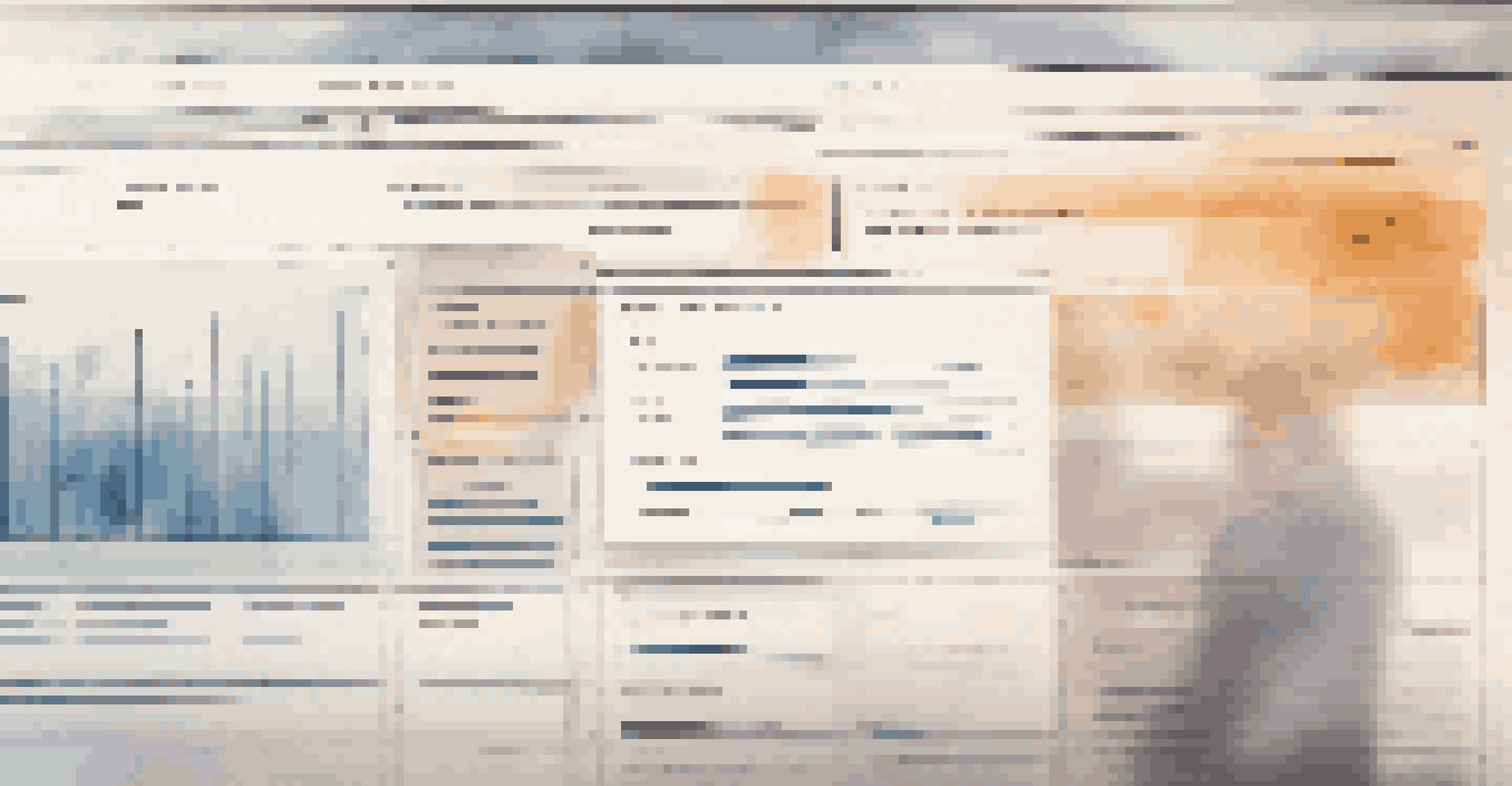Forensic Analysis of Emails: Recovering Digital Evidence

Understanding Forensic Email Analysis and Its Importance
Forensic email analysis is a specialized process that involves examining emails to uncover evidence for legal investigations or cybersecurity incidents. This field is crucial because emails often contain valuable information, such as communications, timestamps, and attachments that can significantly impact a case. By understanding the intricacies of email systems, forensic analysts can extract relevant data that may not be immediately visible.
Email is the most widely used form of communication, and with that comes the responsibility to use it wisely and ethically.
The importance of forensic email analysis extends beyond legal settings; it plays a role in corporate investigations, compliance audits, and even personal matters. For instance, recovering deleted emails can reveal hidden motives or confirm suspicions in a workplace dispute. Therefore, mastering this analysis helps ensure that justice is served and that organizations maintain their integrity.
In a world where digital communication is ubiquitous, the need for effective forensic email analysis has never been greater. Understanding how to sift through the vast amounts of data can mean the difference between a successful investigation and a missed opportunity. As we dive deeper into this topic, we’ll explore the methodologies and best practices that make forensic email analysis a powerful tool.
Common Techniques Used in Email Forensics
Email forensics employs various techniques to recover and analyze digital evidence effectively. One common method involves examining email headers, which contain crucial metadata such as sender and recipient information, timestamps, and server details. By analyzing these headers, forensic experts can trace the origins of an email and establish timelines, which are vital in legal cases.

Another technique involves recovering deleted emails from servers or storage devices. Even if an email appears to be deleted, remnants may still exist within the system’s database. Tools designed for email recovery can help forensic analysts bring these lost messages back to life, providing insight that could change the course of an investigation.
Importance of Email Forensics
Forensic email analysis uncovers vital evidence for legal and corporate investigations.
In addition to these techniques, keyword searches and data filtering are essential in narrowing down relevant information. By using specific search terms, analysts can quickly locate pertinent emails within vast datasets, avoiding the overwhelming task of sifting through irrelevant content. These techniques work together to create a comprehensive picture of the communication landscape surrounding a case.
The Role of Email Metadata in Investigations
Email metadata is often referred to as the 'data about data,' and plays a critical role in forensic analysis. It includes information such as the email's sender, recipient, subject line, and timestamps. Analyzing this metadata can reveal patterns of communication and help establish relationships between individuals involved in a case.
Digital evidence is like a puzzle; each piece, no matter how small, can lead to a bigger picture.
For example, if a suspect frequently communicates with a particular individual, this connection can provide leads for further investigation. Moreover, discrepancies in timestamps may indicate manipulation or fraudulent behavior, making metadata a key element in building a timeline of events. Without this layer of information, many investigations would lack the depth needed for thorough analysis.
In essence, metadata serves as a digital fingerprint of email communications, offering forensic analysts clues that could lead to significant discoveries. By understanding and interpreting this data, investigators can uncover hidden narratives and context that might otherwise go unnoticed.
Challenges in Forensic Email Analysis
Forensic email analysis isn't without its challenges. One major hurdle is dealing with the sheer volume of data generated daily. In corporate environments, employees send and receive countless emails, making it difficult for analysts to pinpoint relevant information amidst the noise. This complexity demands advanced tools and techniques to streamline the analysis process.
Another challenge stems from the diverse email platforms and formats used by individuals and organizations. Each email service often has its own architecture and way of storing data, which can complicate recovery efforts. Forensic analysts must be well-versed in various platforms to effectively navigate these differences and extract meaningful evidence.
Challenges in Email Analysis
Analysts face hurdles like data volume, diverse platforms, and intentional obfuscation.
Additionally, the potential for deliberate obfuscation poses a significant challenge. Individuals may attempt to hide or delete emails to evade scrutiny, which requires forensic experts to employ sophisticated recovery methods. Overcoming these obstacles is crucial for ensuring that the analysis is both thorough and accurate.
Best Practices for Conducting Email Forensics
To conduct effective email forensics, analysts should adhere to best practices that ensure the integrity and reliability of the evidence. One of the foremost practices is to create a bit-for-bit copy of the original data before analysis. This ensures that the original evidence remains untouched and can be re-examined if needed, preserving its authenticity.
Another best practice involves maintaining a clear chain of custody for all evidence collected. This means documenting every step of the analysis process, including who accessed the data, when it was accessed, and what actions were taken. A solid chain of custody is essential for maintaining the credibility of the evidence in a legal context.
Lastly, staying updated with the latest forensic tools and techniques is vital. The digital landscape is constantly evolving, and forensic analysts must be adaptable to new challenges and technologies. By investing in ongoing education and training, professionals can enhance their skills and ensure they are equipped to tackle the complexities of email forensics.
Legal Considerations in Email Forensics
Legal considerations are paramount in forensic email analysis, as improper handling of evidence can compromise an investigation. Analysts must be aware of laws and regulations governing digital evidence, including privacy rights and data protection laws. Understanding these legal frameworks is crucial to avoid potential pitfalls that could render evidence inadmissible in court.
Moreover, consent is a critical aspect of email forensics. In many cases, investigators must obtain permission to access and analyze email accounts, particularly in personal matters. Failing to secure proper consent can lead to legal repercussions and undermine the credibility of the investigation.
Future of Email Forensics
Emerging technologies like AI are revolutionizing the speed and efficacy of email analysis.
Lastly, analysts must ensure that their methods align with the standards set by the judicial system. This includes adhering to guidelines for evidence collection, analysis, and presentation in court. By maintaining this legal awareness, forensic email analysts can navigate the complexities of the legal landscape while effectively uncovering the truth.
Future Trends in Forensic Email Analysis
As technology continues to advance, the field of forensic email analysis is also evolving. One notable trend is the increasing use of artificial intelligence (AI) and machine learning to expedite the analysis process. These technologies can sift through vast amounts of data and identify patterns or anomalies that may require further investigation, significantly reducing the time required for manual reviews.
Another trend is the growing concern over cybersecurity threats, which has propelled email forensics to the forefront of digital investigations. With more sophisticated phishing attacks and data breaches occurring, organizations are prioritizing forensic capabilities to protect their sensitive information. This shift reinforces the importance of being proactive in addressing potential threats.

Finally, as remote work becomes more common, forensic analysts will need to adapt their approaches to accommodate the evolving landscape of email communications. Understanding how to conduct thorough investigations in decentralized environments will be crucial for future success. By embracing these trends, forensic email analysis can continue to be an essential tool in uncovering digital evidence.